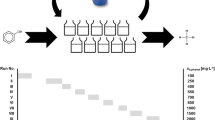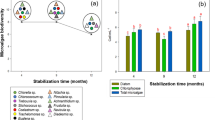Abstract
The relative importance of each of three dechlorinating species to overall organochlorine removal from bleached kraft-mill effluents (BKME) was assessed. Ancylobacter aquaticus A7, Pseudomonas P1, and Methylobacterium CP13, strains indigenous to a BKME treatment system, were tested for growth on chlorinated acetic acids and alcohols, and for adsorbable organic halogen (AOX) reduction in batch cultures of sterile BKME from three sources. A. aquaticus A7 exhibited the broadest substrate range, but could only affect significant AOX reduction in softwood effluents. Methylobacterium CP13 exhibited a limited substrate range, but was capable of removing significant amounts of AOX from both hardwood and softwood effluents. By contrast, Pseudomonas sp. P1 exhibited a limited substrate range and poor to negligible reductions in AOX levels from both effluent types. Mixed inocula of all three species combined and inocula of sludge from mill treatment systems removed as much AOX from softwood effluents as did pure populations of Methylobacterium CP13. When BKME was hydrolysed prior to AOX analysis, the subsequent estimates of recalcitrant, or non-hydrolysable, AOX levels were far less variable than their counterpart total AOX measures. It is suggested that this is a relevant and useful measure of AOX for biodegradation studies.
Similar content being viewed by others
References
Bryant CW, Amy GL, Alleman BC (1987) Organic halide and organic carbon distribution and removal in a pulp and paper wastewater lagoon. J Water Pollut Control Fed 59:890–896
CPPA Standard H.6P (1991) Technical section. Canadian Pulp and Paper Association (CPPA), Montreal
Fulthorpe RR, Liss SN, Allen DG (1993) Characterization of bacteria isolated from a bleached kraft pulp mill wastewater treatment system. Can J Microbiol 39:13–24
Hoffman HJ, Buhler-Neiens G, Lasenka D (1988) AOX in sludge and sediments — method for determination and results. Yom Wasser 91:125–134
Janssen DB, Pries F, Van der Ploeg MJ, Kazemier B, Terpstra P, Withholt B (1989) Cloning of 1,2-dichloroethane degradation genes of Xanthobacter autotrophicus GJ10 and expression and sequencing of the dhlA gene. J Bacteriol 171:6791–6799
Lindstrom K, Mohamed M (1988) Selective removal of chlorinated organics from kraft mill total effluents in aerated lagoons. Nord Pulp Paper Res J 1:26–33
Liss SN, Allen DG (1992) Microbiological study of a bleached kraft pulp mill aerated lagoon. J Pulp Paper Sci 18:J216–221
McKague AB, Jarl M, Kringstad KP (1989) An up-to-date list of compounds identified in bleachery effluents as of January 1989. ‘SSVL-Miljo” 90, project bleaching. AF-1PK, Box 8309, S-104 20, Stockholm, Sweden
Nelson MJK, Montgomery SO, Pritchard PH (1988) Trichloroethylene metabolism by microorganisms that degrade aromatic compounds. Appl Environ Microbiol 54:604–606
Odendahl SM, Weishar KM, Reeve DW (189) Chlorinated organic matter in bleached chemical pulp production. Part II. Measurement techniques. Pulp Paper Can 91:T136–140
Ontario Ministry of the Environment (1991) Preliminary report on the first six months of process effluent monitoring in the MISA pulp and paper sector (Jan 1, 1990, to June 30, 1990). Water Resources Branch, Queens Printer for Ontario. PIBS 1436
SCAN-test Standard SCAN-W 9:89 (1989) Organically bound chlorine by the AOX method. Scandinavian Pulp, Paper and Board Testing Committee, Stockholm, Sweden
Sunito L, Shiu WY, Mackay DA (1988) Review of the nature and properties of chemicals present in pulp mill effluents. Chemosphere 17:1249
Tomar P (1991) The performance of an aerated lagoon for the removal of organochlorine from bleached kraft mill effluent. MASc Thesis, University of Toronto.
Tomar P, Allen DG (1991) Removal of organochlorines from kraft pulp mill effluent by an aerated lagoon. Water Pollut Res J Can 26:101–117
Wijngaard AJ van den, Kamp KWHJ van der, Ploeg J van der, Pries F, Kazemier B, Janssen DB (1992) Degradation of 1,2-dichloroethane by Ancylobacter aquaticus and other facultative methylotrophs. Appl Environ Microbiol 58:976–983
Wyndham RC (1986) Evolved aniline catabolism in Acinetobacter calcoaceticus during continuous culture of river water. Appl Environ Microbiol 51:781–789
Yan G, Allen DG (1994) Biosorption of high molecular weight organochlorines in pulp mill effluent. Water Res 28:1933–1941
Author information
Authors and Affiliations
Rights and permissions
About this article
Cite this article
Fulthorpe, R.R., Allen, D.G. A comparison of organochlorine removal from bleached kraft pulp and paper-mill effluents by dehalogenating Pseudomonas, Ancylobacter and Methylobacterium strains. Appl Microbiol Biotechnol 42, 782–789 (1995). https://doi.org/10.1007/BF00171962
Received:
Revised:
Accepted:
Issue Date:
DOI: https://doi.org/10.1007/BF00171962




